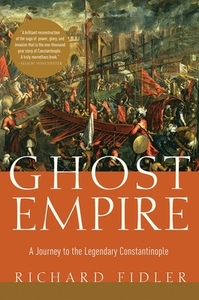Take a photo of a barcode or cover
adventurous
informative
reflective
medium-paced
Plot or Character Driven:
N/A
Strong character development:
N/A
Loveable characters:
N/A
Diverse cast of characters:
Yes
Flaws of characters a main focus:
N/A
I really enjoyed this - as someone who knows frightfully little about Roman history (East Roman history, at least, I've got a passing knowledge of the Republic and early Imperial), it was quite a good biography of a fascinating and important city.
Fidler goes through the entire history of Byzantium come Constantinople come Istanbul through its entire history as a capital of the world from 300AD - 1453AD, an incredible eleven century journey laden with tragedy and destruction, interspersed with anecdotes from his son Joe and his trip to Istanbul in the early 2010's.
Though written largely as pop history, and a fairly skeletal overview of some fairly major European events, it does a good job of giving an overview of an incredible range of time. I found the asides regarding their trip interesting and heartwarming, but they also jarred slightly with the historical text - I would be turning the page desperate to know what the next horror to befall the great city was only to find a few pages of describing how his son likes a particular Turkish warm coffee.
Regardless, very enjoyable and consumable and has done its job sparking interest in the history of the Queen of Cities.
Fidler goes through the entire history of Byzantium come Constantinople come Istanbul through its entire history as a capital of the world from 300AD - 1453AD, an incredible eleven century journey laden with tragedy and destruction, interspersed with anecdotes from his son Joe and his trip to Istanbul in the early 2010's.
Though written largely as pop history, and a fairly skeletal overview of some fairly major European events, it does a good job of giving an overview of an incredible range of time. I found the asides regarding their trip interesting and heartwarming, but they also jarred slightly with the historical text - I would be turning the page desperate to know what the next horror to befall the great city was only to find a few pages of describing how his son likes a particular Turkish warm coffee.
Regardless, very enjoyable and consumable and has done its job sparking interest in the history of the Queen of Cities.
A highly ambitious book with a large scope but I think it works very well. Highly enjoyable and very informative.
informative
medium-paced
adventurous
informative
medium-paced
adventurous
medium-paced
A fascinating easy to read account of the establishment of the Roman Empire's Constantinople realm, its highs and lows and tumultuous end. I found it very engaging and was surprised by its connections to places and things elsewhere such as Venice and the Starbucks symbol. I highly recommend this book to anyone with an interest in history.
Trigger warnings: war, death, murder, torture, assassination, graphic descriptions of wounds and medical procedures.
This is a history of Constantinople under Roman rule, but juxtaposed against the author's experiences travelling to Istanbul with his teenage son, and it was fascinating. I know very little about the eastern Roman empire, so from that perspective this was wonderful. It's an engaging and compelling history, and Fidler's personal anecdotes of his travels really made both the modern and historical city come alive. The travel aspect of it allowed Fidler to tell fairy tales and legends that involve Constantinople or the Eastern empire in some way.
Basically? This was great. But my real takeaway is that the emperor wore thigh high purple boots and that is a mental image that will stay with me forever.
This is a history of Constantinople under Roman rule, but juxtaposed against the author's experiences travelling to Istanbul with his teenage son, and it was fascinating. I know very little about the eastern Roman empire, so from that perspective this was wonderful. It's an engaging and compelling history, and Fidler's personal anecdotes of his travels really made both the modern and historical city come alive. The travel aspect of it allowed Fidler to tell fairy tales and legends that involve Constantinople or the Eastern empire in some way.
Basically? This was great. But my real takeaway is that the emperor wore thigh high purple boots and that is a mental image that will stay with me forever.
The scope of this book is ambitious, and yet Fidler manages to squeeze in 500 pages the story of one of the most beautiful and fascinating cities of the ancient world. Constantinople became the richest, most lavish and most important Christian city in the world. The history of this enchanting city is presented in an accessible and engaging way: from its beginnings as a Greek settlement in 657 BC with the name of Byzantium, to its inauguration as the new Roman capital by Constantin I bearing the new name of Constantinople, down the dazzling number of rulers and generals, including shrewd emperors and fascinating empresses (whose lives featured murders, beheading, betrayals, incest, nose mutilation and blinding), to the prolonged siege that saw the city fall to the sultan Mehmet II of the Ottoman Turks.
The reader follows Fidler and his son, Joe, who travel to Europe in 2014, on a quest to visit the places of the late Byzantine Empire. Part travelogue part history book, the author mix legends with historical accounts to recreate the wonder and richness of the vanished empire that lasted for a millennium after the collapse of the Western Roman empire (Constantinople was founded in 330 AD and the Byzantine empire ended in 1543 AD). The author takes some interesting detours from his tale to introduce the Western romans (which Fidler calls Latins reserving the name Romans for the Byzantines), the Persian empire, the Arabs, the Vikings, etc. without losing the focus of the book.
Fidler is a marvelous storyteller, despite not being a historian, his work is well researched. He provides maps and images of architectural structures, statues, artifacts etc., includes precise dates and places, carefully retracing the genealogical roots of important historical figures. The end of the book includes notes and an extensive bibliography for reference and further study.
I would highly recommend this book to any reader, you won’t be disappointed by this one. 4.5 stars
The reader follows Fidler and his son, Joe, who travel to Europe in 2014, on a quest to visit the places of the late Byzantine Empire. Part travelogue part history book, the author mix legends with historical accounts to recreate the wonder and richness of the vanished empire that lasted for a millennium after the collapse of the Western Roman empire (Constantinople was founded in 330 AD and the Byzantine empire ended in 1543 AD). The author takes some interesting detours from his tale to introduce the Western romans (which Fidler calls Latins reserving the name Romans for the Byzantines), the Persian empire, the Arabs, the Vikings, etc. without losing the focus of the book.
Fidler is a marvelous storyteller, despite not being a historian, his work is well researched. He provides maps and images of architectural structures, statues, artifacts etc., includes precise dates and places, carefully retracing the genealogical roots of important historical figures. The end of the book includes notes and an extensive bibliography for reference and further study.
I would highly recommend this book to any reader, you won’t be disappointed by this one. 4.5 stars
informative
reflective
medium-paced
informative
medium-paced



